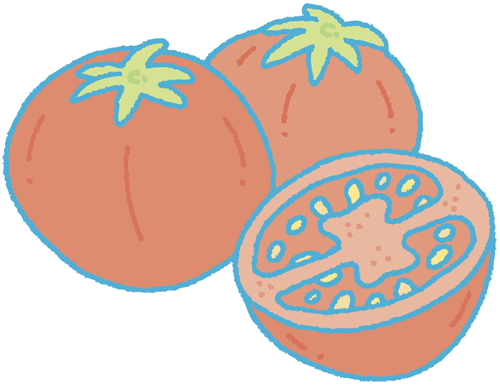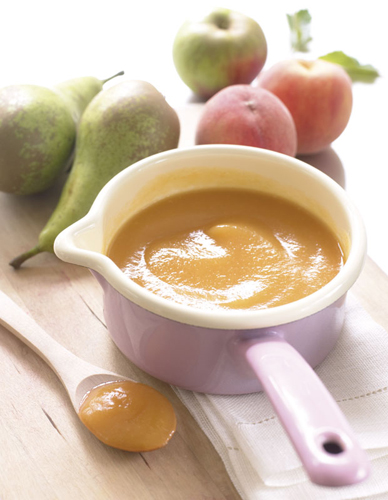While many of the foods you offer your family may be a little heavy for your young baby, there is no reason why you can’t involve him in family meals, and purée some of the elements of every meal you prepare. Babies love to feel part of the crowd, and will enjoy eating the same food as everyone else.
| Q: |
My baby keeps reaching for food from my own plate; should I let her try?
| | A: |
There is no reason that your baby shouldn’t try the food on your
plate, provided there is nothing there that could cause her to choke, or
which may be inappropriate for babies .
In fact, eating from mom and dad’s plate is a good way to introduce
your baby to new flavors and tastes, and encourage her to join in with
family meals from an early stage. If she particularly likes something,
mash it up for her or give her a finger-food sized slice that she can
manage herself.
|
| Q: |
We sometimes get take-out, and my baby always wants a taste; is this safe?
| | A: |
As long as it’s not too fatty or rich, or contains foods that are inappropriate for little ones,
you can most certainly offer small tastes. There is plenty of research
to indicate that children’s tastes are established in early childhood,
and the more he learns to eat at an early age, the more varied his
palate will be later on. If your baby has food allergies, you have to be
particularly careful; take-out is often a source of hidden allergens.
|
| Q: |
Can I purée family food for my baby?
| | A: |
By all means. There are some foods that are inappropriate for babies and you should offer only healthy foods to your little one—avoid salt and sugar.
In the early stages,
you will need to ensure that you make a purée that is liquid enough for
your baby to slurp up from a spoon since she won’t have developed her
chewing skills yet. It’s also a good idea to establish a few first foods
on their own—several types of fruit, and several types of vegetables,
for example, before moving on to fish, chicken, and meat. If you launch
straight into family meals, it can be difficult to work out which foods
are problematic, in the event that there is a reaction.
Remember that first foods are just tastes, too, and your little one won’t require a whole balanced meal for some months to come.
|
| Q: |
Should I offer snacks to my baby if she seems hungry between feeds?
| | A: |
Snacks are not really essential at this age, as your baby will be
getting most of her calories and nutrition from milk. If she is hungry
between feeds, you could try offering another small meal, with some
purée and finger foods. You should also be sure that she is getting
enough milk between “meals” to keep her going. Once again, first foods
are about “tastes,” and not designed to fill your baby. If you are out
and about, snacks can keep her going, but make sure they are healthy.
Soft ripe fruit such as
nectarines or slices or chunks of banana and melon are a good start.
Some little ones can manage toast fingers, pieces of bread, rice cakes,
and even oatcakes. Be sure to keep an eye on her in case she chokes.
|
| Q: |
My baby refuses to eat meat; how can I tempt him?
| | A: |
It’s not surprising that many little ones are not keen on meat.
It can be very dry if it’s not cooked properly, and difficult to chew if
it has not been puréed properly. I would recommend cooking meat or
chicken with root vegetables, such as chicken with sweet potato and
apple, or beef with carrots and dried apricots. See the delicious recipe
Beef, Squash, and Tomato Purée
too. You can also try offering little batons of chicken for him to gnaw
on, as he may enjoy helping himself rather than being spoon-fed, and
he’ll become accustomed to the taste and texture in this way.
|
| Q: |
At what age is it appropriate to serve dessert to my baby?
| | A: |
Dessert is something that most children (and adults!) look
forward to, in order to round off a meal. It is not necessary, but it
does provide some incentive for finishing the main course! There is no
reason why your little one can’t have a healthy dessert, such as fresh
fruit purée (see Peach, apple, and pear purée), a healthy homemade cookie or muffin, some dried fruit, or a yogurt or fresh fruit popsicle at the end of a meal.
While every single
expert insists that you should never offer a reward for eating a meal,
there is no doubt that the prospect of something a little special will
tempt children to have one taste or one more bite of their main meal.
The secret is to create desserts that are as healthy as their main
courses, but with enough sweetness or flavor to make them special. A
baked apple with a little maple syrup and raisins would provide a treat
for the whole family and can be puréed or mashed for your baby.
|
Eating out
Babies can be
adventurous eaters, and will probably be happy to pick at lots of things
on your plate. If in doubt, give him plain pasta with a little cheese,
bread, vegetables, mashed potatoes, well-cooked scrambled eggs, risotto,
and any fresh, ripe fruits, mashed until smooth. If there are no
concerns about food allergies, and the food isn’t too spicy or salty,
feel free to offer your baby tastes of sauces too.
Beef, Squash, and Tomato Purée
The sweet squash and tomatoes here help to make the flavor of beef more palatable for fussy babies. As your baby gets older, the cooked beef can be mashed into the squash and tomatoes, and served with small pasta shapes.

10 minutes
14–15 minutes
2 plum (Roma) tomatoes 1 tsp olive oil 1/2 cup ground round 1/4 small butternut squash, peeled, seeds removed, and grated 2/3 cup vegetable stock, or water
Cut a small cross in the
top of each tomato. Put them in a heatproof bowl and cover with freshly
boiled water. Let stand for 30 seconds, then drain and plunge in cold
water. Peel off the skins. Cut the skinned tomatoes into quarters, scoop
out the seeds, and chop the flesh.
Heat the olive oil in a
large frying pan or wok and sauté the beef, stirring well, until
browned and crumbly, 2–3 minutes. Add the squash and chopped tomato and
sauté, stirring, until the vegetables are softened, about 2 minutes. Add
the stock and bring to a boil, then reduce the heat, cover, and simmer
for about 10 minutes.
Cool slightly
before puréeing the contents of the pan in a blender, adding a little
extra boiled water if the purée is too thick.
Freeze in individual
portions. When needed, thaw overnight in the refrigerator. Reheat until
piping hot, stir, and let cool slightly before serving.
Peach, Apple, and Pear Purée
Ripe, seasonal fruits can make a plain applesauce a little more interesting. I like to use peaches or nectarines, but apricots or plums are also good.
If the fruit is not very sweet, you can add a teaspoon of agave nectar,
which is available from whole food markets and some supermarkets.

10 minutes
10 minutes
2 ripe peaches 1 sweet apple, peeled, cored, and diced 1 ripe pear, peeled, cored, and diced 2 tbsp water
Cut a small cross in the
top and bottom of each peach and put them in a heatproof bowl. Cover
with boiling water and let stand for 30 seconds, then drain and plunge
in cold water. Peel off the skins. Cut the peaches into quarters, remove
the pits, and dice the flesh.
Put the peaches, apple,
and pear in a saucepan with the water. Bring to a boil, then cover,
reduce the heat to low, and cook gently until the juices have run from
the peaches and the fruits are all soft, about 10 minutes.
Cool slightly, then
transfer to a blender and purée until smooth. Serve warm, or cool
quickly and refrigerate to serve cold. The purée can be frozen in
individual portions; thaw for 1–2 hours at room temperature when needed.
|